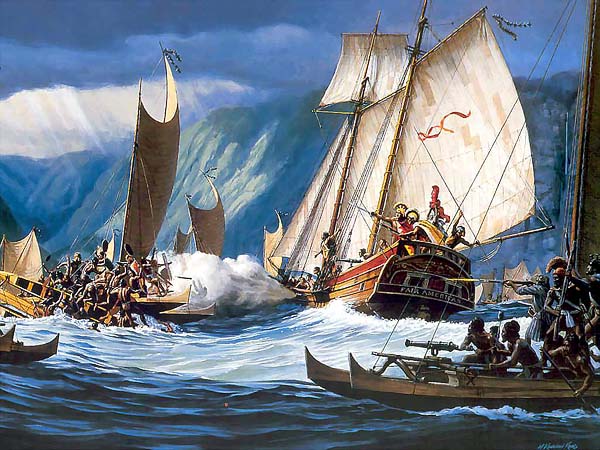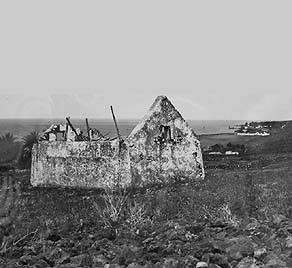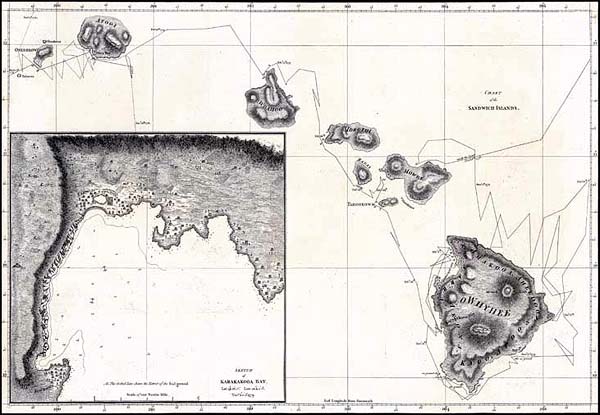 |
 |
 |
|||||
|
|
|||||||
|
|
|||||||
| |
|
|
|
|
“I think that looking at it with Hawaiian eyes,” Hannah considers, “Captain Cook might be like a footnote to the social change that was occurring just with the tension between Kiwala‘o and Kamehameha and their chiefly cousins, all of whom were vying for power in the political vacuum created by the death of Kalaniopu‘u.”
|
||
|
|
||
“Before Kamehameha, Kalaniopu‘u had established dominion over this island,” Hannah points out. “But it was not a settled piece, because otherwise there wouldn’t have been all of those young cousins percolating up to a sort of boiling point. Desha describes all of the battles that were taking place as one cousin was nudging up against another. "We see masses of people engaged by one aspiring chief or another, and the quickness with which those troops were put into action across the land and seascape. It is really pretty amazing.” In February 1778, Captain James Cook arrived in Hawai‘i after seeking a Northwest passage around Alaska and traveling down the Pacific Northwest of North America. His visit to Hawai‘i Island at Kealakekua Bay ended in a skirmish in which Cook, four of his soldiers, and several Hawaiian chiefs were killed. Kamehameha was a young chief present at that time.
|
|
|
“We have a sense of the numbers of people involved in the political tumult that was happening in Hawai‘i in the late 18th century,” Hannah continues. “Kamahameha’s rise to power is often simplified as resulting from the mana he was able to accrue and the people that he was able to command or lead. But when we read Desha’s Kekuhaupi‘o, we see how many rivals there were—the genealogical, martial and political vying for power that occurred on this island—and we see what a momentous effort it was for Kamehameha to assume the leadership that he did.” An important aspect of Kamehameha’s success was his appropriation of two Westerners from the ships Eleanora and Fair American. “[T]he ship Eleanora commanded by Captain Metcalf (Meka) arrived,” Desha writes. “This was a sealing ship from the north and was accompanied by the schooner Fair American commanded by the young son of Captain Metcalf, only eighteen years of age…. "On board the ship Eleanora was John Young, later called ‘Olohana by the Hawaiian people, who was later one of Kamehameha’s very strong helpers in his conquest of his kingdom” (Desha, 2000: 230).
|
“The arrival of Captain Metcalf was pivotal,” Hannah states. “He was subdued at or near to Kaupulehu by the chief Kame‘eiamoku, and what was significant about this is twofold. As far as I know it’s the only time that a Hawaiian captured a foreign vessel, the Fair American, which was captained by Metcalf. The Fair American was pressed into military service by Kamahameha upon the presentation of it to him by Kame‘eiamoku. “The taking of the Fair American is among the various exposures to gunpowder and musketry that are made at that time with the arrival of merchants. By the time Kamehameha is able to move the battle for dominion over to the Island of O‘ahu, even the chiefesses of Hawai‘i Island are skilled in firing the muskets, and they were a part of the battles for control over the island of O‘ahu.”
|
|
| |
|
|
“Isaac Davis (and John Young) helped Kamehameha conquer these islands,” Billy says. “He taught them gunnery and everything else. They lashed canoes together and put the cannons on them. Plus they used European tactics.” Both Young and Davis took up residence at Kawaihae, marrying into chiefly families. By the time Captain George Vancouver reached Kawaihae, February 14, 1793, Kamehameha had established control over Hawai‘i Island. Desha writes that “...at this time he [Vancouver] met with Kamehameha who was then living there. The ali‘i Kamehameha had reached fifty-seven years of age” (Desha 2000: 360).
|
||
|
|
||
Of his landing at Kawaihae, Vancouver wrote that “…nothing but the most civil, attentive, and friendly deportment was experienced from all classes of the people. The village consisted only of straggling houses, of two classes; those appropriated to the residences of the inhabitants were small, mean, miserable huts; but the others, allotted to the purposes of shading, building, and repairing their canoes, were excellent in their kind: in these occupations several people were busily employed, who seemed to execute their work with great neatness and ingenuity” (Vancouver, 1798 II: 116). According to Kamakau, Vancouver “was urged to sell muskets and powder, but he replied ‘It is not right to sell things for killing people.’ Vancouver was a Christian and a true Englishman. He may well be called the father of the Hawaiian people. He was the first to point out ‘the true God in heaven.’"
|
|
|
"On this second visit of Vancouver," Kamakau continues, "he met Kamehameha and his foreigners, Isaac Davis and John Young—called ‘Olohana.’ He thanked Kamehameha for the good care he had given the foreigners, and when they told him that the chief had given them lands he did not ask to take Young back to England, but recommended both men to the chief’s care. In return for the chief’s kindness to them and for the food with which he had been himself provided he gave Kamehameha a bull and a heifer brought from Monterey in California. The Hawaiians were grateful for these cattle, and because they stared so strangely they were given the name ‘Pig-beef’ (pua‘a bipi). This was the beginning of the wild herds of Waimea and Mauna Kea” (Kamakau 1990: 164).
|
| |
|
|
At this time, the struggle to unite the islands was in full swing. Hannah explains: “The chief Kahekili had united the islands of Maui, Kaho‘olawe, Lana‘i, Moloka‘i and O‘ahu into a package. Kahekili and Kamehameha negotiated a peace for the later years of Kahekili’s life, but his heirs and assigns were not able to hold what Kahekili had gathered to him. That is as big a part of the Kamehameha story as Kamehameha himself. "If Kahekili’s heirs and assigns had perhaps had more skill, or perhaps better tutors, they certainly had the material resources to be on par with Kamehameha. But that Kamehameha was able to exert dominion over them speaks both to the strength of Kamahameha and to the weakness of those who followed Kahekili.”
|
||
|
|
||
“That invasion of O‘ahu wasn’t a fair fight,” Billy asserts. “The poor guys in Honolulu just got wiped out. Davis and Young taught them Prussian tactics, and by then they were trained with musketry and such. They had a feint on one side, then they used the envelopment on the other side, and ended up driving them up the Pali. This is recorded history. Even when you study tactics back in Washington, they have ‘Kamehameha’s tactics.’ "To conquer Kaua‘i, that would have been quite an undertaking going across that channel. It can be treacherous at times. But that king over there, I think he just thought it was better to 'join the party' then. So he peacefully joined up with Kamehameha and there was no fight to get Kaua‘i.”
|
|
|
“Pu‘u Kohola is the cornerstone upon which Kamehameha's establishment is founded,” Hannah concludes. “Up to that point Kamehameha was one of many cousins jockeying for power. He was a brilliant man. By virtue of his birthright alone, he was not necessarily going to be a ruling chief; but by virtue of his skill and talent, he was able to ascend to that position. "Part of his brilliance seems to be the way in which he led: when he was successful in battle, he was not hard-handed upon the lands which he had won, nor their people. Rather, he engaged in physically rebuilding the land that he had torn down in war. That was a major strategy on his part. "He quickly established himself as the good chief, and the people who had lived under chiefs of questionable temperament seem to have quickly come to the side of Kamehameha. There’s brilliance in that."
|
|
|
|
“He seems to be a man who followed his gods and his teachers devoutly, and in that there’s humility. And that humility in the life lived off a battlefield, where certainly ambition and aggression are the traits that are well rewarded, speaks to a balance in his life. We hear of how he tended his body, maintained his well being. There are the stories of him working the land as well as the seas, and those are often traits that we hear about those ruling chiefs who are presented as paragons of virtue. So he seems to have been a virtuous man, a strong man.”
|
||
|
|
||
"With the arrival of missionaries we see, by the early 19th century, the position of Westerners expanding from being a 'footnote' to the story of Hawai‘i, to being a story in themselves." And that takes us to a discussion of missionaries.
|
||
|
|
||
|
|
|
|
|
|

|
| Kawaihae Home | Map Library | Site Map | Hawaiian Islands Home | Pacific Worlds Home |
|
|
|
|
|
|
|||
| Copyright 2006 Pacific Worlds & Associates • Usage Policy • Webmaster |
|||














